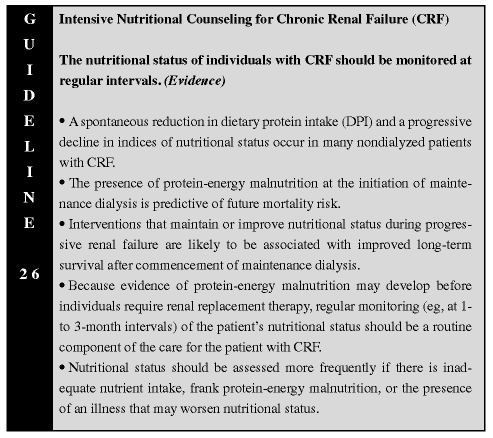

PEM is common in people with ESRD and several studies indicate that it is often present at the time that MD therapy is initiated, indicating that deterioration in nutritional status often predates the onset of renal replacement therapy.16,21,75,128,201 Indeed, research indicates that patients with CRI who are not receiving nutritional management often demonstrate evidence of deterioration in nutritional status before dialysis therapy is initiated.196,198 Moreover, biochemical and anthropometric indicators of PEM present at the initiation of dialysis are predictive of future morbidity and mortality risk.22,23,25,42,52,199,201,212 A progressive decline in dietary protein and energy intake, anthropometric values, and biochemical markers (eg, serum albumin, transferrin, cholesterol, and total creatinine excretion) of nutritional status has been documented in patients with progressive CRF consuming uncontrolled diets. The decline in spontaneous protein and energy intake, serum proteins, and anthropometric values is evident when the GFR falls below 50 mL/min and is particularly notable below a CrCl of about 25 mL/min.196,197 In one prospective observational study, for each 10 mL/min decrease in CrCl, DPI decreased by 0.064 ± 0.007 g/kg/d, weight declined by 0.38% ± 0.13% of initial weight, and serum transferrin decreased by 16.7 ± 4.1 mg/dL.196 A positive correlation between energy intake and GFR has also been reported, independent of the prescribed protein intake.197
In summary, evidence of PEM may become apparent well before there is a requirement for renal replacement therapy. Interventions that maintain or improve nutritional status are likely to be associated with improved long-term survival, although this has not been proven in randomized, prospective clinical trials. Therefore, it is recommended that regular monitoring of the patient's nutritional status should be a routine component of predialysis care.